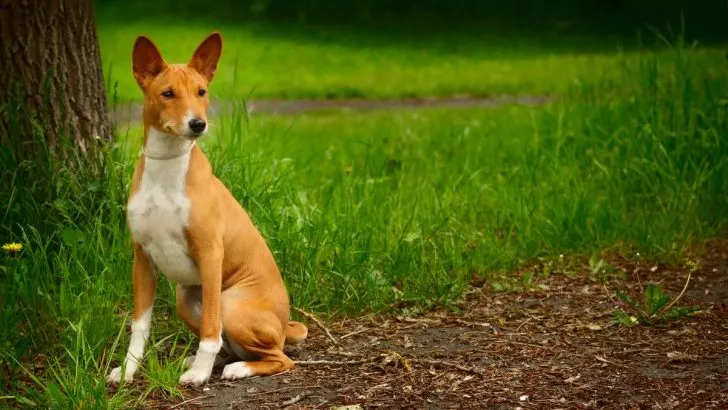Basenjis may not say much, but their striking coats certainly do.
If you, like me, are amazed by this pawesome breed, you’ve landed in the perfect spot to explore all the vibrant Basenji colors.
With this breed, every shade and pattern is a shout of nature’s creativity! Let’s dive into the colorful world of these beautiful African Barkless dogs!
4 Standard Basenji Colors
According to the American Kennel Club breed standards, Basenjis sport four accepted colors.
These colors range from the deep, glossy black to the warm chestnut red background, and from the striking black stripes to the clean white markings.
The primary colors, accentuated by distinct lines of demarcation like the classic black mask and brindle stripes, not only meet the breed standards but also highlight their elegant, short coats.
Let’s check them out!
1. Black & White
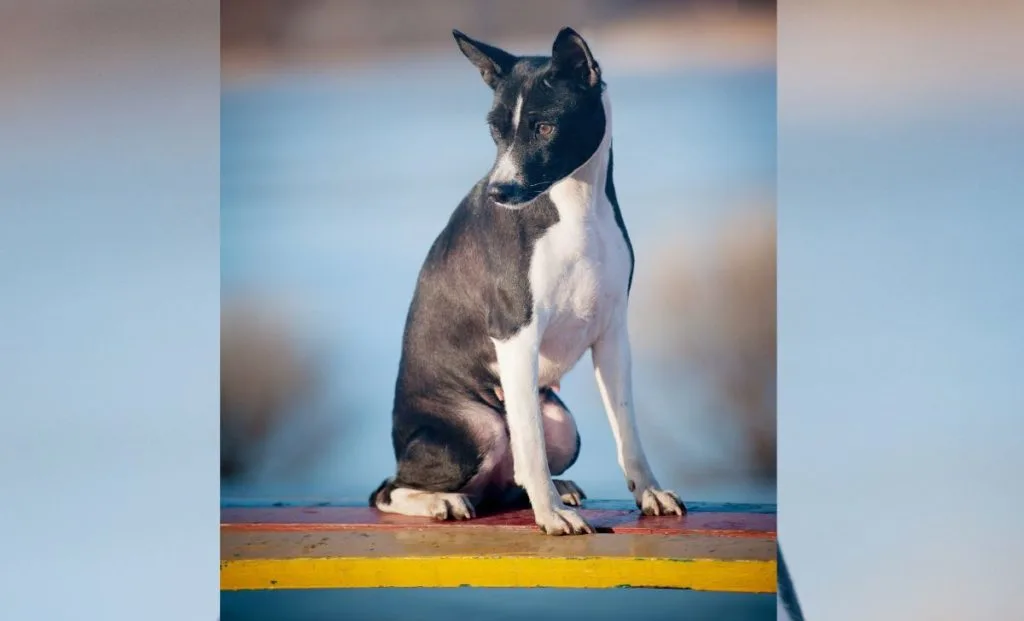
Can Basenjis be black and white? Of course! Just so it happens that this Basenji color is one of the standard shades, and quite common too.
The black & white Basenji carries a distinctive look that is both elegant and striking. The primary color of black may dominate their coat, enriched with bold, black stripes or a solid black base.
The black looks very smooth and shiny on their short coats, especially when exposed to sunlight! The tan markings of a black and white Basenji make this pup standout even more.
This is elegantly contrasted by white markings that often appear on their feet, legs, and most notably, a white blaze on the face.
The blaze is not unique to the Basenji but is also found in other dog breeds. Notable examples include Collies and Australian Shepherds.
2. Black Tan & White

This tricolor coat is a blend of deep, glossy black, vibrant tan, and white markings. Each Basenji color is distinctly demarcated to create a striking appearance.
In the Black, Tan, and White Basenji, the black color covers much of the body, providing a rich, deep background that enhances the visibility of the other colors.
This diversity is a result of selective breeding and natural evolution, with early imports and later travelers contributing to the wide array of colors and patterns seen today.
In fact, the early Basenji imports typically showcased these colors that are still considered standard today.
Such a Basenji color pattern is often seen in purebred Corgis, Beagles, and Bernese Mountain dogs.
3. Brindle & White
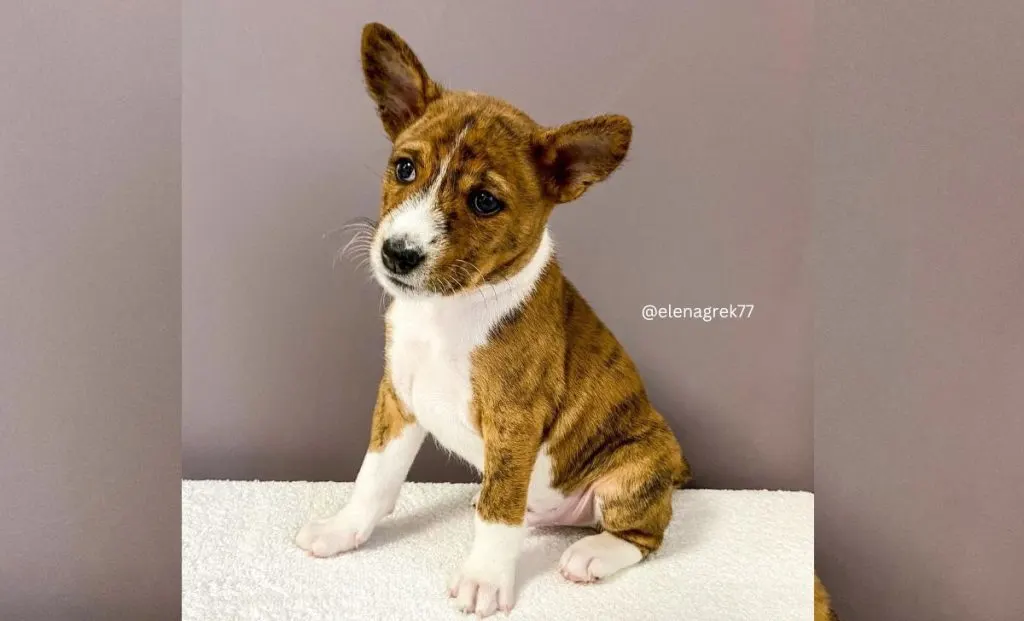
The brindle and white Basenji vividly displays its unique coat pattern, where the brindle shows through with striking clarity. This is quite a unique color that many Basenji breeders strive to accomplish!
Brindle color pattern refers to a coat pattern characterized by streaks and swirls of dark color imposed over a lighter base.
In brindle and white dogs, these markings typically appear in shades of black or very dark brown, overlaid on a background that can range from gold to a chestnut red, creating a tiger-stripe effect.
Some brindle Basenjis feature distinctly visible stripes of brindles, sparse yet clear against a red background. Meanwhile, others display such a dense concentration of brindle markings that the background of chestnut red is almost completely left out.
Besides our African bush things, we can also notice these patterns in Pit Bulls, Boxers, and Greyhounds.
4. Red & White
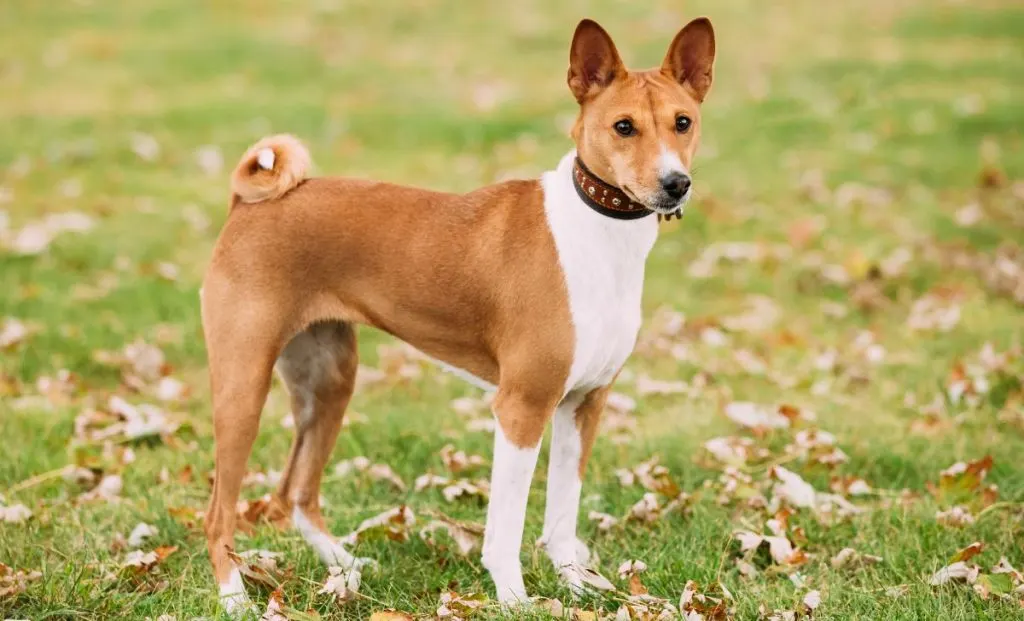
This classic color combo has a distinct line of demarcation, setting the fiery reds apart from the brilliant white markings.
The white markings are clean and bright, as they contrast sharply with the deeper body color. The create a beautiful visual effect that includes white hairs typically seen on the feet, chest, and tail tips.
This chestnut red Basenji is highly valued and often considered to be in the best position for showing, thanks to its popularity and the striking contrast it presents.
Despite some breeders’ reservations about more diluted or mixed patterns, the traditional red and white remains a cornerstone of Basenji color patterns.
5 Rare Basenji Colors
Rare Basenji colors include those less commonly seen and often highly sought after by breeders and enthusiasts.
Among these are the pure black Basenji and the intriguing color trindle, which is a complex pattern that mixes the tricolor with brindle markings.
The diluted black and unique variations of brindle color patterns, such as those barely visible beneath a dark overlay.
Let’s check them out.
1. Black Brindle & White
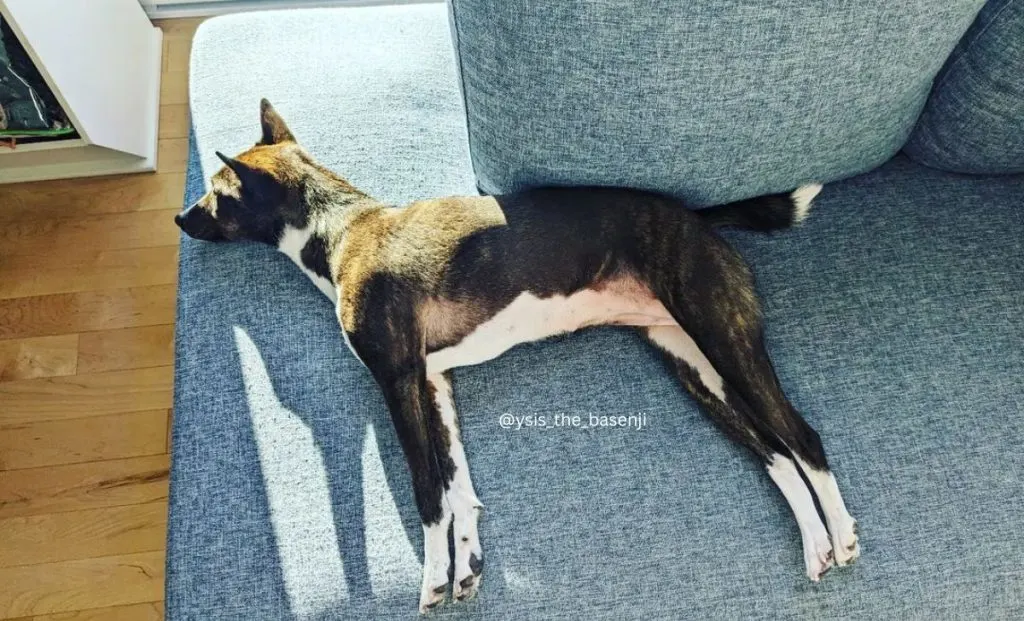
This eye-catching combination adds depth and uniqueness to their appearance, making them standout among other dogs.
There is also a brindle tricolor Basenji pup, which the AKC simply classifies as tricolor for show purposes. However, dog breeders often refer to this as the color trindle .
Black brindle & white Basenjis are not allowed to compete in AKC shows, due to this color not being standard.
Although rare, these colors can sometimes be seen in Cane Corso dogs. However, they are quite common in Bull Terriers and French Bulldogs.
2. Blue Cream & White
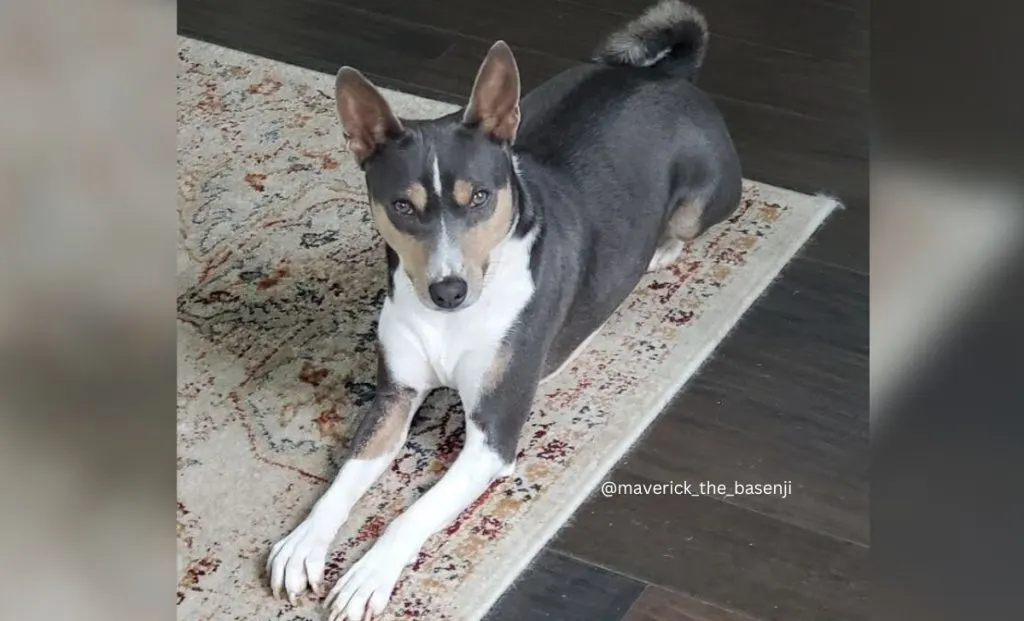
The Blue Cream & White Basenji is a very rare but very stunning color variation. Oh, just look at this pup!
This coat color results from a diluted black base color, which gives it a unique soft bluish hue paired with cream. This softer and more subdued color palette still maintains clear distinctions in its markings.
The creamy areas typically blend smoothly into the lighter blue (grayish), while patches of white provide a bright contrast. Of course, these patches are typically found on the chest and feet.
Due to their diluted black coats, blue Basenjis may be at risk of developing Color Dilution Alopecia (CDA). This condition is commonly seen in breeds with the “blue” coat color variation (1).
3. Cream & White

The Cream & White Basenji presents a softer, more subdued look with its pale, almost pastel-like cream base color complemented white markings.
This coloration is quite rare and very sought-after! It provides a striking contrast to the more common darker hues of the Basenji dog breed.
Although Cream & White Basenjis are less common, they may be found among reputable breeders who specialize in rarer color variations.
Don’t you think it differs a lot from the more vibrant Basenji color patterns?
4. Mahogany Tan & White

The Mahogany Tan & White color in Basenjis showcases a rich, deep mahogany (akin to the red of tricolors), contrasted sharply by white markings that are often found on the feet, legs, and chest.
The warmth of the mahogany hue combined with vivid white markings creates a visually appealing contrast. Well, to give you a comparison, we can often see these shades in different breeds such as Irish Setters and Vizslas.
Basenji pups sport a typically solid mahogany coat that can have variations that include white features.
However, despite their beauty and appeal, these colors are considered rare and are not recognized as standard colors by the American Kennel Club (AKC) for Basenjis.
This means they are seldom seen in official dog shows under the AKC.
5. Sable & White

Sable & White Basenjis are distinguished by their sable coloration. These dogs have individual hairs that are banded with multiple colors, predominantly black over a red or tan base. They blend into areas of white, typically on the feet, chest, and tail tip.
The rarity of these dogs can be attributed to later imports, as these colors may not have been present in the native dogs. But like Mahogany Tan & White, they do not align with AKC breed standards for showing.
This makes them rare in the show ring, though they remain beloved by breeders and owners for their unique beauty.
Apart from that, this is truly an elegant coloration that gives the breed quite a gentle appearance.
4 Basenji Markings
As we explore further our beloved Basenji colors, we encounter specific markings that are very specific for this fascinating breed.
While some markings are common and others rarer, they all look amazing and make every Basenji pup unique!
Here, we’ll discuss four distinct Basenji markings, one of which is recognized as a standard by the AKC, and the others adding aesthetic diversity to the breed.
1. Brindle Markings
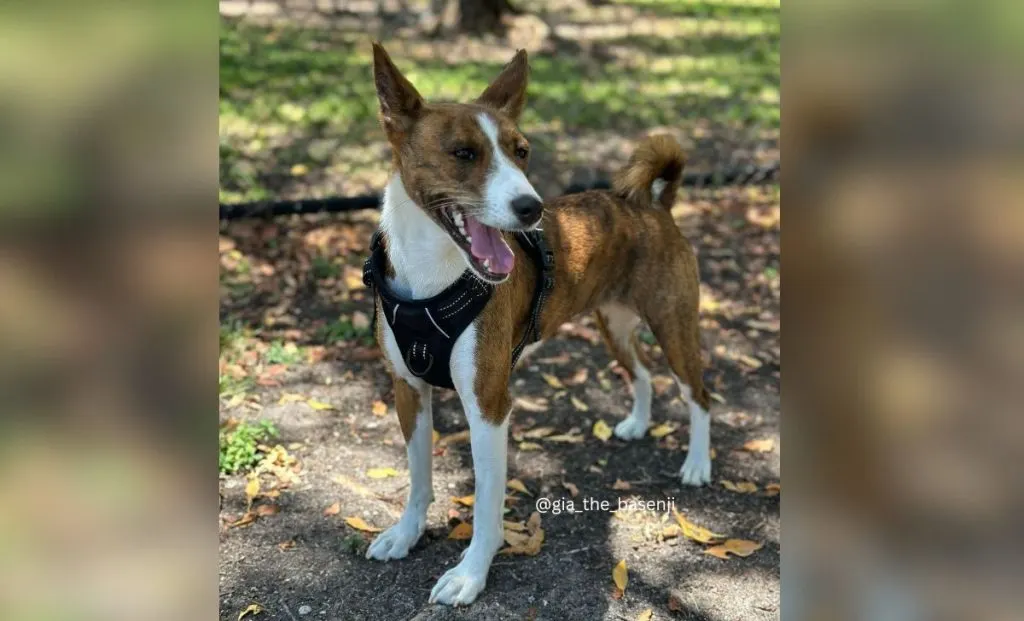
These are tiger stripes, of course! Complementary to the true warrior, such as the wild thing – Basenji!
Brindle markings on these pups consist of dark stripes over a lighter base, which can vary, as seen in coat colors that we previously mentioned.
These markings are officially recognized by the AKC as standard, which is important for paw parents whose first Basenji is born to be a star!
Now, this distinctive pattern has a striking contrast and a wild appearance. I think that the brindle markings blend beautifully across the dog’s body, enhancing their sleek, muscular build. Don’t you?
2. Black Mask

The black mask is a common marking where the face or the muzzle of the Basenji is covered with a black color, contrasting sharply with the rest of the body’s lighter color.
The black mask can appear in conjunction with other colors and markings. It is a very versatile and widely appreciated facial feature.
We can also see this marking in different breeds like Belgian Malinois, Whippets, and Pugs.
3. With Cap
The ‘with cap’ marking refers to a specific marking coloration on the crown of the head. It can often be seen as a darker patch of fur, contrasting with the lighter neck and shoulders.
Cap Basenji markings are quite cute, as they give each dog a unique “capped” appearance.
4. Black Saddle
A black saddle marking refers to a large, black patch that covers the back and sides of the Basenji, resembling a, you’ve guessed it – saddle.
This marking typically contrasts with a lighter body color and can be accompanied by white feet, legs, and underbody.
You know who else sports a distinctive black saddle? A German Shepherd, of course!
What Makes The Basenji A Unique Dog?
Considered one of the oldest breeds of domesticated dogs, and their ancient lineage contributes to their unique genetic makeup and the characteristics that define them today.
The range of Basenji colors definitely adds to their appeal.
However, one of the most notable features of this dog breed is its barklessness.
While not completely silent, Basenjis don’t bark like other dogs. Instead, they produce a variety of sounds, including a distinctive yodel-like noise known as a “baroo,” thanks to the unique shape of their larynx.
This trait makes them very appealing for those interested in a quieter dog!
Aside from that, Basenjis are often likened to cats because of their grooming habits, aloof demeanor, and independent nature.
They frequently clean themselves and can be selective with their affections too.
Basenjis have several unique physical characteristics, including tightly curled tails and wrinkled foreheads, which give them an expression of constant curiosity.
They are just too cute!
Which Color Basenji Should I Choose?
While the fun Basenji colors might be your initial attraction to the dog, they should not be the sole consideration.
Instead, focus on the dog’s health, temperament, and how well they will fit into your lifestyle!
Basenjis are energetic and intelligent dogs that require engagement and exercise, so think about how well you can meet these needs.
Generally, the Basenji breed does not have color-linked health issues as prominently as some other breeds might.
However, it’s essential for breeders and owners to be aware that genetic diversity, including color genetics, can influence overall health.
For instance, certain coat colors in dogs have been linked to specific health conditions in other breeds (2). However, no direct connections have typically been made within Basenjis.
The feeling of most breeders is that maintaining genetic diversity, including the preservation of less common colors like cream or sable, is vital for the health of the breed.
This diversity may help to reduce the risk of inherited diseases that can be more prevalent in breeds with more restricted gene pools.
By choosing a Basenji based on a responsible approach to genetic diversity and health, rather than color alone, you’re contributing positively to the breed’s future!
References:
1. Kim, J., Kang, K., Sohn, H., Woo, G., Jean, Y., & Hwang, E. (2005). Color-dilution alopecia in dogs.. Journal of veterinary science, 6 3, 259-61 . https://doi.org/10.4142/JVS.2005.6.3.259.
2. Webb AA, Cullen CL. Coat color and coat color pattern-related neurologic and neuro-ophthalmic diseases. Can Vet J. 2010 Jun;51(6):653-7. PMID: 20808581; PMCID: PMC2871368.

Meet Iram, a devoted veterinarian, passionate dog lover, and current Ph.D. candidate at Utrecht University in the Netherlands. Seamlessly blending her roles as a vet and content writer, Iram channels her love for dogs into heartfelt narratives.
Since childhood, Iram nurtured a dream of becoming a vet, a passion that runs deep in her family. Having now fulfilled that dream, she’s eager to share her acquired knowledge. In her writing, Iram not only explores the emotional bond between humans and their canine friends but also integrates her veterinary expertise, offering readers a holistic understanding of their beloved pets.
